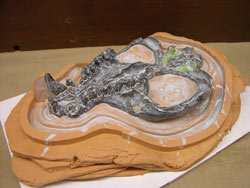Casting
 Choosing a casting material
Choosing a casting material
Specimen casting can be done in either epoxy resin, polyurethane resin, polyester resin,or plaster. Choosing the best casting material for a particular project depends upon many factors
• Resins - Resins can be colored and capture more detail than plaster, but all resins require access to a fume hood for safe use.
• Epoxy – is often chosen to cast small fossils requiring extremely high resolution.
• Polyurethane – is often used to create light-weight medium-large molds. It cures quickly and produces little heat while curing thereby causing less degradation of the mold.
• Polyester – is a good choice for larger casts. It is cheaper than either epoxies or urethanes.
• Plaster – Plaster is easy to cast but may not capture as much detail. Plaster dried to an opaque white. While pigments can be added, it may be difficult to color plaster during mixing.
Cleaning the mold
Before any casting takes place, the mold should be well cleaned with alcohol, using a clean lint free rag. The cleaning removes any traces of separator and any dirt left from the specimen. The mold should then be left for 1-2 days for the rubber to completely cure. When using a silicone or polyurethane mold no special mold preparation is necessary, but latex molds should be sprayed with mold release before use.
Casting in plaster
Plaster is easier to cast than polyester resin, but will not have the quality of detail that a resin can capture. In addition, plaster is opaque and lacks the slightly translucent appearance of bone, which makes it less suitable for display purposes. Because it is difficult to color plaster before mixing, it is better to use a white cast and paint it in the desired manner later. To keep the paint from soaking into the cast two or three thin coats of Butvar should be painted onto the cast and allowed to dry completely before painting.
Plaster is made by adding powdered plaster to water. The mix should not be too thick, about the consistency of melted ice cream. The cast is made by painting a thin coat of plaster into the mold, then adding more plaster on top of the first layer while it is still wet, to a depth of approximately 1/16".Once this layer has hardened, more plaster can be added until the cast has reached the desired thickness. The walls of the cast should be thick enough to be sturdy. Burlap or fiberglass can be also used to strengthen a plaster cast.
Once the plaster has completely dried, the cast can be removed from the mold. The mold should then be cleaned with water and the cast trimmed and cleaned up using sandpaper or an X-acto knife.
Casting in resin
Today, many molds are cast in resin due to its strength and adaptable working properties. Resins can also be colored with powdered pigments, oil paint, or resin colors to almost any color, making them very useful for reproducing fossils. A neutral, medium grey is the useful for making scientific research casts. This color shows the detail well and photographs well also.
ALL RESINS AND CATALYSTS ARE NOXIOUS MATERIALS. Always work in the fume hood and wear nitrile rubber gloves and an apron. Avoid breathing in the dust from hardened resin and also talc or Cab-O-Sil powders. Resins should be stored in the original container and kept in a flammable liquid storage cabinet. Keep the catalyst separate. Click here to read more on Health and Safety when using these materials.
Polyester resin for most large molds will be painted on in layers, allowing one layer to gel before proceeding with the next. In some smaller molds one layer may be enough to fill the entire mold. Polyester generates heat during the chemical reaction which makes it set. Because of this, If the material is too thick the heat generated can cause the cast to shrink, or in extreme cases can cause the cast to crack. For this reason, resin should not be more then 1/4 -1/2" thick for each layer. The number of layers needed depends on the size of the mold. Very large molds need the addition of fiberglass strand or mat for extra strength.
Polyurethane resin is usually cast solid, by pouring the resin into the mold through a hole left in the mold, known as a sprue. It can also be painted on in layers. Setting times vary with the product but are generally much quicker than either polyester resin or epoxy. The sprue and any flashing from the edge of the mold are removed after demolding. Because there is little odor associated with this product, one might be tempted to assume that the material is less hazardous to use, but like all resins it should be used and cleaned up within a fume hood.
For detailed procedures for casting in both polyester and plaster download the Basics of Moldmaking by Marilyn Fox, Preparator at the Peabody Museum of Natural History, Yale University.

